The Leachianus Gecko is the largest known living gecko measuring anywhere from 8 to 17 inches in length (depending on the type).
They are a native animal to New Caledonia, a group of islands in the South Pacific.
Just as their name suggests, they are exclusively found on New Caledonia (an island known for its natural beauty and biodiversity) and they are arboreal, meaning they like to live up in the trees.
Leachie Geckos are popular among reptile owners due to their unique voices and colors.
Because they are a nocturnal species, they will stay up at night and growl, squeak, and yip. A Leachie’s thick body and stumpy tail come in earthy shades to makes it easy for them to blend into trees and other plants.
In the wild, Leachie Geckos live up high in tree hollows at very warm temperatures, so they need a similar replication of this environment to live in.
An exotic but hardy pet, living up to 20 years old, they must be properly raised and housed. Keep on reading to learn exactly how to care for them.
What Is A Leachie Gecko?
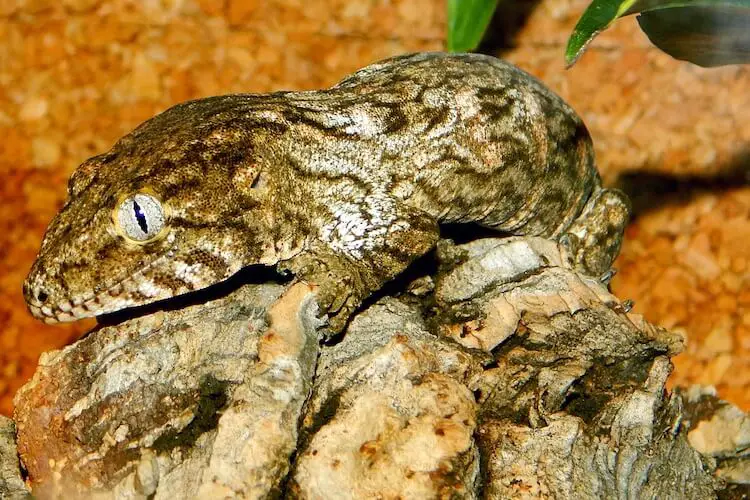
Leachie Geckos, sometimes known as the New Caledonian Giant Gecko is a large arboreal gecko, originating from the group of islands northeast of Australia with two distinct subspecies:
- Rhacodactylus leachianus henkeli (found on the island of Grande Terre)
- Rhacodactylus leachianus leachianus (found on Pine Island)
Depending on the region of New Caledonia they are native to, they have a wide variety of coloration and patterns, including: browns, blacks, greens, and grays.
There are two key contributors that make Leachie Geckos different from other species:
- Their size – they are very well recognized as the largest gecko in the world
- Their vocal cords – owners have shared stories on how they like to bark, yip and growl at night
Other than their size and unique voice, Leachie Geckos are distinctive for having the ability to lose and regrow their tail. They will detach their tails if they feel threatened. Not to worry, though! Tails will regenerate.
Not social geckos, they tend to hide and sleep during the day and require plenty of positive handling experiences. Because of these reasons, they are not the best reptile for first-time pet owners or children.
The habitat for Leachianus Geckos should consist of plenty of hiding places and mimic the tree hollows that they would naturally sleep in. They also must be kept at warm temperatures, ranging between 73℉ and 80℉. This will afford your lizard to many hiding places in a relatively moist environment.
| Lizard Quick Facts | |
|---|---|
| Common Names | New Caledonian Giant Gecko, Leachianus Gecko |
| Scientific Name | Rhacodactylus Leachianus |
| Adult Size | 8-17 inches, 200-320 grams |
| Lifespan | 15-20 years |
| Diet | Crickets, roaches, mice and fruit |
| Tank Size | At least 18x18x24 inches and 30 gallons with plenty of hiding places and climbing areas |
| Humidity & Temperature | 73-80°F and humidity should be kept between 60-75% |
| Popular Alternatives | Crested Gecko, Gargoyle Gecko, Mossy Prehensile-Tailed Gecko and Rough-Snouted Giant Gecko |
Leachie Gecko Care Guide
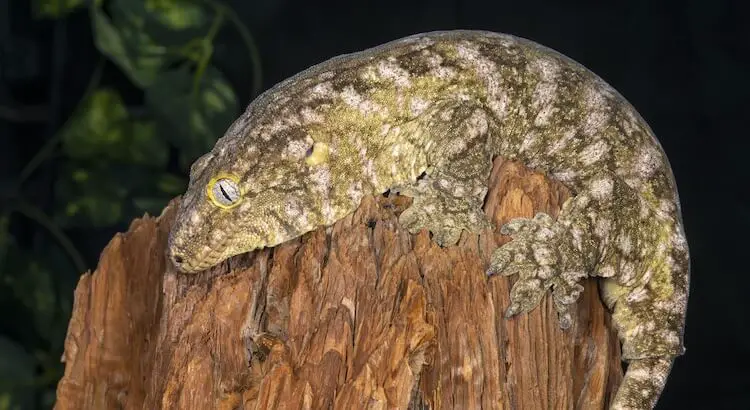
They frequently visit tree tops during the day when they are asleep and rest in the nooks and crannies of high tree canopies.
The temperature in New Caledonia is warm, and they should be kept between temperatures of 73℉ and 80℉. They should also have lots of hiding places to stay during daylight hours.
Leachianus Gecko’s Tank and Enclosure
Habitats that are opaque or ABS plastic also help the gecko feel secluded. Tank size depends on the life stage of your gecko:
- Hatchlings during their first few months should be housed in a 5-10 gallon tank
- Juveniles can be kept in a 10-20 gallon tank
- By 12 months of age (adults), they should be comfortable in a 30 gallon tank
Geckos at all stages may be intimidated by enclosures that are too large. Tall, smaller terrariums help them feel safer. New Caledonian Giant Geckos find themselves comfortable in upright screen enclosures, or terrariums with foam backgrounds and front-opening doors.
As they hide themselves in the wild, Leachie Geckos do best with plenty of hiding and climbing spots.
Cork bark, paper towel rolls, thick branches, small boxes, PVC pipe, bamboo, and sturdy plants will help them climb or conceal themselves.
Lighting
Leachie Geckos are nocturnal and will not come out during daylight hours, however, they should still have access to UVB lighting.
Compact top and T5 canopies work well in terrariums to ensure the lighting effect isn’t diminished. Extra lighting is not required, but lights should not be turned on at night so as to not to interrupt their circadian rhythms.
Leachianus Gecko Heating and Temperature
Depending on the time of day, the tank temperature should never fall below or exceed the 65℉-85℉ range; ideally high 70s during daylight hours and low 70s at night.
If heating devices are needed to obtain this range, then red bulbs with low wattage (or an under tank heater) are ideal. Heat pads placed on the side of the tank also work.
The humidity of a Leachie Gecko’s habitat should generally be kept between 60% and 75%. However, as this species is susceptible to bacterial infection, it is best to let the humidity decrease to less than 60% regularly to prevent build-up.
Another way to keep the habitat healthy (without allowing build-up) is to mist the walls of the enclosure but not any foliage.
Substrate
A variety of substrate options can work: organic soil, coconut fiber, high-grade mulch, peat-based potting soil, or paper towels all work.
These substrates will ideally mimic a more natural atmosphere while not holding in too much moisture. The substrate should be changed often enough so that it does not start growing any infectious microorganisms.
Hatchlings should use paper towels so that it’s easier to change several times a week.
| Tank Tips | |
|---|---|
| Tank Type | Glass, screen or plastic |
| Lighting | UVB lighting in the daytime (optional) |
| Best Substrate | Rich soil, coconut fiber, mulch or paper towels |
Feeding Leachie Geckos
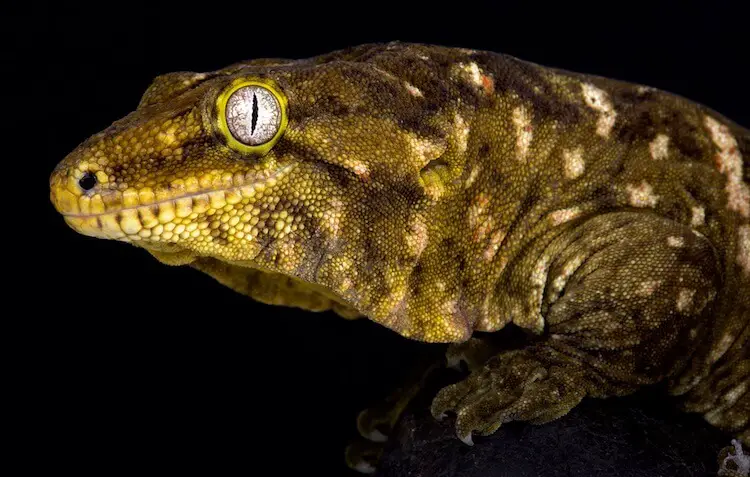
Leachianus Geckos are naturally omnivorous and spend their time on the islands of New Caledonia eating crickets, roaches, small mammals or lizards, fruit, and various nectars.
They may eat about four times a week and are not particularly fussy eaters, but they do require a balanced diet due to their natural eating habits in the wild.
It is important that Leachie Geckos get both their fruits as well as their protein from live feed.
Feeding four times a week will allow their food to ripen for some time before consuming it and they tend to enjoy food that has been sitting for a short period of time before consuming it.
They may eat it off the ground. But, as they prefer to consume their food up high, placing a food dish raised off the floor of the enclosure is a good idea.
Many owners use a pre-balanced diet using human grade ingredients (intended for the Crested Gecko), as part of the meal they offer to their lizard.
Leachie Geckos may consume two ounces of Crested Gecko food every time they are fed (which should be 3-4 times weekly). Fruits and live prey such as roaches, crickets, or mice should be fed in addition to the Crested Gecko diet.
Live feed should be fed 1-2 times a week and dusted with calcium and Vitamin D3 supplements:
- Hatchlings can start eating small crickets coated with vitamin D3 and calcium and meal replacement. They should be fed 4 times a week.
- Adults may be more likely to eat the mice than insects and only need to be fed 2 or 3 times a week.
Fruit should be fed three times a week and left to sit for a short amount of time if not eaten immediately. Food should then be removed once a week if it is not fully consumed.
Chlorine-free water should be provided everyday in a bowl that is resistant to tipping. Most Leachie Geckos will have no problem with drinking out of bowls, however some will need to be sprayed with water at least once a day.
| Diet Summary | |
|---|---|
| Vegetables | 0% of diet |
| Insects | 20% of diet. 2 crickets or roaches 1-2 times a week |
| Fruits | 80% of diet. Bananas, mangos, pears, peaches, grapes or berries three times a week |
| Supplements Required | Baby mouse 1-2 times a week. Calcium and Vitamin D3 |
How To Keep Them Healthy
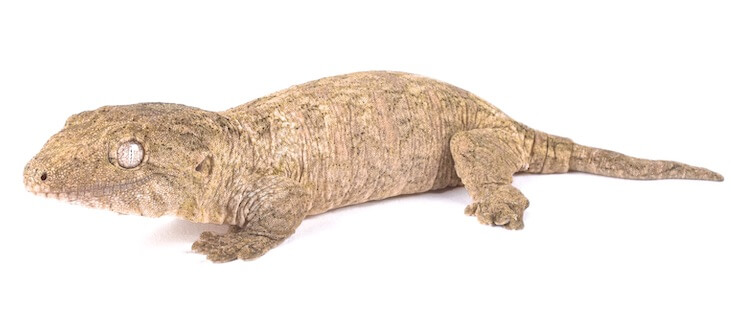
Leachie Gecko hatchligs should not be handled immediately as they need to become accustomed to their tank environment.
They may be more ready to handle at around 2 months of age. Once they reach this age, handling should be done very carefully, as these animals can be flighty. They may jump or bite, but they should build tolerance as handling is increased.
With clean hands, you should handle your new Gecko for 15-20 minutes at least once a day for two consistent weeks. Afterwards, it should feel more comfortable in being handled and will be less likely to bite.
Gloves should be worn to hold them at first and handling should be infrequent at first, but may become as frequent as every other night as tolerance is built.
Bathing
The Leachianus Gecko should not suffer from retained sheds if they have proper humidity levels and, like similar Geckos, are known for eating their own shed.
If the Gecko does have a retained shed, it can be placed in a container filled with damp paper towels for half an hour.
The walls should be misted, but the rest of the enclosure should be kept vaguely damp without being too moist.
Tank Cleaning
They should be misted daily and the enclosure should be cleaned regularly. When a tank is cleaned, the substrate should be replaced as well as any foliage that may have bacterial growth.
Tanks should be deep-cleaned at least once a month. Water and food bowls should not be kept any longer than two days without changing.
Feces should be spot-cleaned daily. Because they are a large species, their feces will be slightly larger and can have a strong smell. As a defense mechanism, they may also spontaneously excrete liquid waste.
Typical waste should be relatively solid with brown and white parts.
| Signs They Are Healthy | Sickness Symptoms |
|---|---|
| Vocalizing at night | Not eating for extended periods of time |
| Hiding and sleeping during the day | Any signs of skin or bacterial infection |
| Eating every couple of days | Baggy skin |
Leachie Gecko Lifespan
A healthy Leachianus Gecko will live up to 20 years in captivity.
Some common diseases for Leachie Geckos are calcium deficiency, internal parasites and egg binding. These can all be fatal if not treated by a veterinarian promptly.
Leachie Gecko Behavior and Temperament
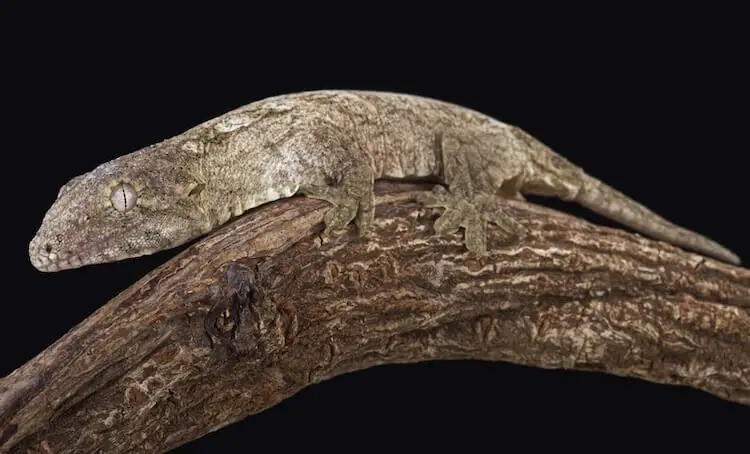
The Leachie Gecko is a cautious reptile to different species, however they are territorial against their own and may jump or bite.
Females tend to be aggressive towards males if they do not accept the male’s attempts at copulation. Because of their territoriality, it is possible that a Leachianus Gecko may have cage aggression.
Leachie Geckos love to communicate to others and at night can be heard making a wide range of noises from yipping, growling and whistling to hissing and grumbling.
Due to being nocturnal, they are most exciting in the evening as they display their natural behavior when it is dark and they are roaming in their tank. During the day, the Leachie Gecko will be found sleeping in hiding holes or up-high near the top of the enclosure.
In terms of handling, they are not beginner friendly lizards and should be allowed to acclimate to their enclosures for several months before being handled.
Hatchlings will tend to be very energetic and jump often. Because of this, they should be handled with care so that they do not injure themselves. The best way to pick up a Leachie is to grasp the back of its neck and support its bottom.
As your Leachie Gecko matures into a juvenile handling can become more frequent. Most tend to grow more tolerant of their human handlers after six months of age.
If you wish to have two Leachie Geckos in the same tank, they must both be raised together from a very young age. Otherwise, they will become very territorial.
Appearance Of Leachie Geckos
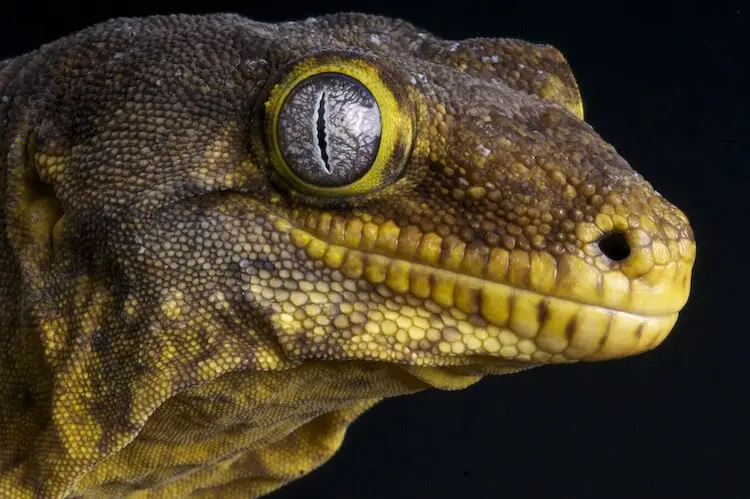
This lizard’s appearance is interesting because their tails are separated into two segments: a short, thin section attached through a fold of skin to a broad base. Their tails have the ability to detach and regenerate; the new tail always looks different from the original.
The physical difference between males and females can be found about 3” from their head.
Female geckos will have femoral or pseudo pores that lack a distinctive dark pit that males have and are also a little slimmer.
Instead their pores may appear smooth or dimpled. Males also have pre-anal pores as well as a post-anal hemipenile bulge.
New Caledonian Giant Gecko Size
The most notable physical distinction of a Leachianus Gecko is its immense size, hence their New Caledonian Giant Gecko name.
The size of can vary based on the stage on their age, gender and subspecies:
- Grande Terre Geckos is the larger of the two. Hatchlings are born at about 3.5 to 4 inches long from head to tail and adults will be between 14-17 inches and weigh about 200g-320g.
- Pine Island Geckos will be born 3 to 3.5 inches long and after 12 months will range between 8-12 inches and weighing 113g-250g.
Colors
The colors of Leachie Geckos will vary depending on the subspecies too.
Grande Terre Leachies tend to be less vibrant showing off its browns, grays and black color with matching striping, white side-banding or blotching, or black spots.
Pine Island Leachies are more colorful, ranging from green to brown and gray. They will also have blending colors of pink or lavender, orange or salmon bands, or white bands with black spots.
How To Sex Leachie Hatchlings
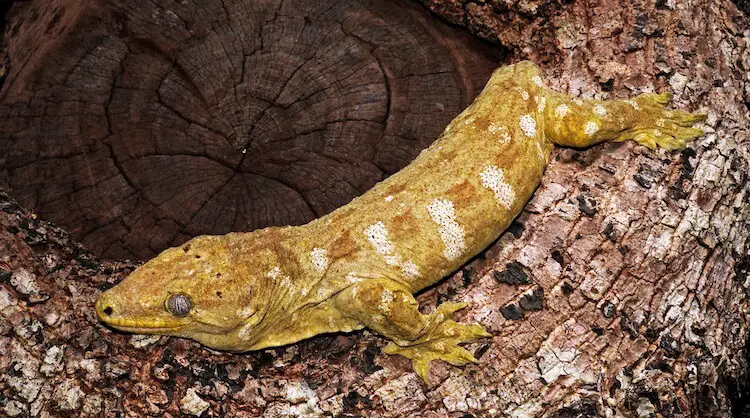
Because Leachie Geckos can be territorial animals (especially females), it is best that mates become acclimated to each other before breeding. They should each start in separate cages placed next to each other.
Releasing the male into the female’s enclosure should only be done after assurance that the female will be submissive to it.
When the male Leachie is interested in copulating with his female partner, he will likely bob his head and make clucking noises.
If breeding is successful, the female will lay two soft-shelled eggs per clutch. Depending on her calcium reserves, she may lay up to four clutches per breeding season. Eggs will take between 60 and 90 days to hatch. Eggs should be incubated between 60℉ and 80℉.
When the temperature is higher, incubation time is decreased and there is a greater chance of the hatchlings being male. If the temperature is lower, the opposite of both is true.
Leachianus Gecko Hatchlings
After being incubated in a safe, temperature-appropriate enclosure, hatchlings are well-suited to an enclosure that is 5-10 gallons. Baby Leachianus Geckos can be kept in a shoebox, so that they are not overwhelmed.
Make sure to use the same substrate, feeding schedule, and diet-type as that of an adult (just not as much food).
These hatchlings are born about 3”-4” in length and grow to nearly adult size in 12 months, by which point they can move from a juvenile to adult terrarium.
Leachie Gecko Price
On the more expensive side of reptiles, Leachianus Geckos can cost between $600 and $1,000 USD. At one point, they were so rare, their price soared to $2,000 USD. However, captive breeding has improved their prevalence.
They tend to be more expensive because hatchlings and juveniles take longer to develop to breeding age, and they do not produce many offspring.
This reptile can only be acquired if they were bred in captivity, as they are no longer exported from New Caledonia.
Care Guide Summary
| Pros | Cons |
|---|---|
| Very unique because of their size and vocalization. | Can be flighty and may jump if not raised properly. |
| Hardy animals and may live up to 20 years. | Can be territorial (towards other geckos). |
| They’re entertaining to watch when they’re awake. | They’re expensive. |
The Leachianus Gecko is an interesting species, consisting of bright colors and noises which can bring any home to life.
Though they are very intriguing, Leachianus Geckos are not recommended for novice owners. Experience with similar reptiles such as the Gargoyle Gecko or the Crested Gecko will prepare you to care for these giants.
The Crested Gecko is a similar species, originating in the same region, but is more friendly and easier to care for.
A Leachie Gecko can be quite expensive to take care of. Not only are they expensive pricey, but their requirements come in a slightly larger portion than those of other geckos.
With the right accommodations and correct handling, these reptiles can make great pets. Not only are they exquisite to look at, but they will fill your home with chirps and company for 20 years.

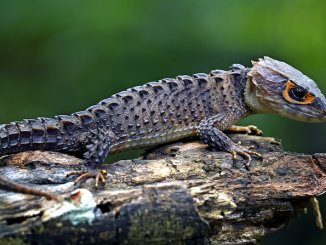

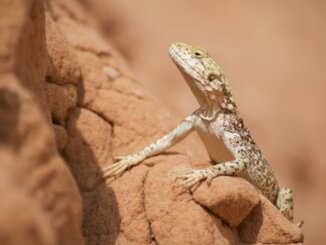
This really helped me learn about these Geckos thank you so much.
My Leaching got out and had been missing for a week . I live in Canada a it has been very cold. We found her last night. There is no regamortis sorry about my spelling she is still very soft and movable. I don’t want to give up on her how long should I wait before believing she is gone Iam keeping her as warm as possible not sure what else to do